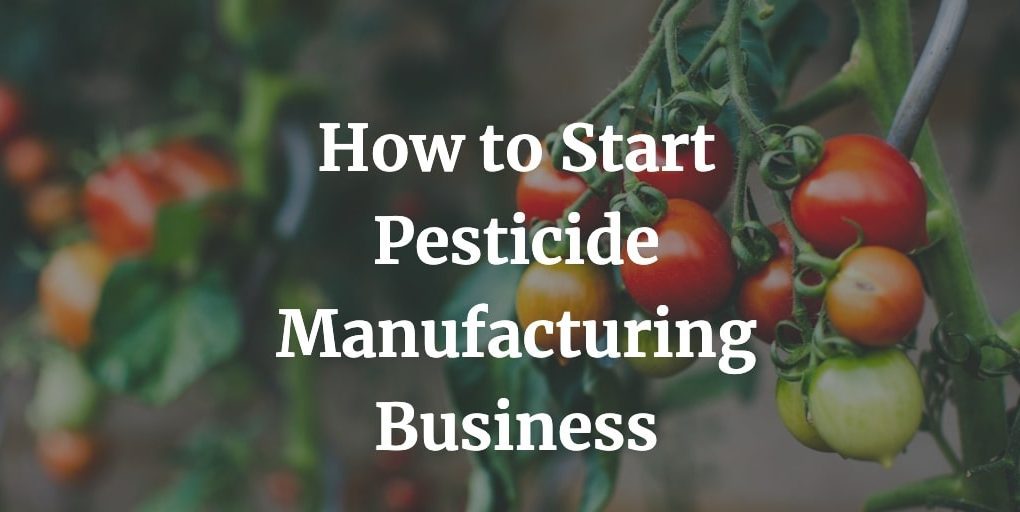Pesticide holds an important position in the Indian agrochemical industry. Hence, starting a pesticide manufacturing unit can be a profitable venture. Here in this article, we have listed the essential steps to follow to start a pesticide manufacturing business with costs, machinery, profit margin, production process, and more.
Table of Contents
Pesticide Market in India
The pesticide market in India is big. According to a report by the IMARC Group, the Indian pesticide market size reached INR 245.2 Billion in 2023. The report predicts the market to grow ( CAGR of 6.0%) and reach INR 421.7 Billion by 2032. The main reason for this increasing growth is enhanced agricultural activities and the demand for high-yield crops. More and more farmers need to protect crops from pests and diseases.
8 Steps to Start a Pesticide Manufacturing Business

1. Conduct Market Research
The first step is to determine the types of pesticides that are in demand in the market. It can be herbicides, insecticides, fungicides, and bio-pesticides. You need to do market research and study your competitors to understand their strengths and weaknesses. Also, know more about the regulatory requirements. It includes the Insecticides Act of 1968 and the guidelines set by the Central Insecticides Board and Registration Committee (CIBRC).
2. Write a Business Plan
A detailed business plan is a crucial document for starting a manufacturing business. It not only works as a roadmap for future activities but is also an essential document for funding needs. While creating your plan document, mention your business goals, strategies, and financial projections. Key components of a business plan include:
- Executive Summary: An overview of your pesticide business and objectives.
- Market Analysis: Feedback from your market research.
- Product Line: Details about the types of pesticides you will manufacture.
- Marketing Strategy: How you plan to promote and sell your pesticide products.
- Financial Plan: Estimated costs, revenue projections, and funding requirements.
3. Register Your Business
You will need to register your pesticide manufacturing business. The most popular options are a sole proprietorship, partnership, LLP, or private limited company. CIBRC and other relevant authorities.
4. Procure Essential Licenses to Manufacture Pesticides
a) Insecticides Manufacturing License
It is a mandatory license to produce pesticides. Apply to the Directorate of Agriculture of your respective state. You’ll need to submit an application form, your business plan, details of the manufacturing site, and proof of technical qualifications.
b) Central Insecticides Board (CIB) Registration
You will need to obtain approval from the CIBRC to manufacture and sell pesticides. Apply with detailed information about the pesticide, including its chemical composition, safety data, and intended use. This also involves submitting efficacy and toxicity data.
c) Consent to Establish (CTE) and Consent to Operate (CTO) from the State Pollution Control Board (SPCB)
Apply to your state’s Pollution Control Board with details about your manufacturing process, pollution control measures, and site layout. First, you’ll get a CTE, and once your setup is complete, you need to get the CTO.
d) No Objection Certificate (NOC) from Local Authorities
Apply to local municipal or panchayat offices with your project details and site plan.
e) Factory License
Apply through the Chief Inspector of Factories in your state with your factory layout, health, and safety plans.
f) Goods and Services Tax (GST) Registration
It is a mandatory tax registration for businesses. Register on the GST portal to get a unique GST Identification Number (GSTIN).
g) Trade License
It is a general business operating license. Apply to your local municipal corporation with your business details.
5. Arrange Funds
Securing adequate funding is essential for setting up your manufacturing plant and operations. Approach banks for business loans. Explore government schemes like the MSME loans or the Mudra loan scheme. Seek investment from venture capitalists or angel investors.
6. Set Up Pesticide Manufacturing Plant
Choose a location with good infrastructure and proximity to raw material suppliers. Purchase the necessary machinery and equipment for production, such as mixers, grinders, and filling machines. Source high-quality raw materials like active ingredients, solvents, and packaging materials.
7. Pesticide Production Process
Below is a step-by-step manufacturing process for pesticide production:
- Raw Material Procurement: Purchase high-quality active ingredients and solvents.
- Formulation: Mix the active ingredients with solvents and other additives to create the pesticide formulation.
- Quality Control: Test the formulation for efficacy and safety.
- Packaging: Fill the formulated pesticide into appropriate containers and label them.
- Storage: Store the packaged products in a controlled environment to maintain their efficacy.
8. Marketing and Distribution
Develop a strong brand identity. Use multiple channels such as online marketing, distributors, and retailers to reach your target audience. Also, offer excellent customer service to build a loyal customer base.
Related: Top Small-Scale Chemical Business Ideas
Frequently Asked Questions
What is the profit margin in the pesticide manufacturing business?
The profit margin in the pesticide manufacturing business can range from 20% to 40%, depending on various factors such as production efficiency, market demand, and competition.
What licenses are required to start a pesticide manufacturing business in India?
You need a manufacturing license from the CIBRC, GST registration, and other local permits.
How much investment is required to start a pesticide manufacturing business?
The investment can range from INR 1.3 crore to INR 2.8 crore, depending on the scale of operations.
How can I ensure compliance with regulatory requirements?
Regularly review the Insecticides Act, of 1968, and guidelines from CIBRC. Conduct internal audits and maintain proper documentation.
What are the key factors to consider when choosing a manufacturing location?
Consider factors such as proximity to raw material suppliers, infrastructure, transportation facilities, and regulatory compliance.

NextWhatBusiness Research Desk represents the editorial research team at NextWhatBusiness, comprising business consultants and industry analysts with experience across small, medium, and franchise-led enterprises. The team focuses on data-backed insights, market research, and structured business information to help readers understand trends, opportunities, and operational realities across industries.
Editorial oversight provided by Rupak Chakrabarty, Editor, NextWhatBusiness.



